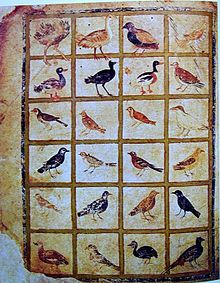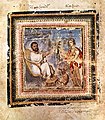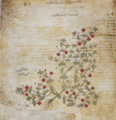Vienna Dioscurides

The Vienna Dioscurides or Vienna Dioscorides is an early 6th-century
The 491
History
Throughout the Byzantine period the manuscript was used as the original for copies of the work that were given to foreign leaders, including the Arabic edition of Abd al-Rahman III of Spain for the creation of which the Byzantine Emperor Constantine VII sent a Greek copy and a translator.[3] A note recording the name of one Michael of the Varangian Guard is also found in the text.[2]
The manuscript was restored and a table of contents and extensive
Illustrations

The manuscript has 383 extant full-page illustrations of plants out of the original 435 illustrations. The illustrations fall into two groups. There are those that faithfully follow earlier classical models and present a quite naturalistic illustration of each plant. There are also other illustrations that are more abstract. The majority of the illustrations were painted in a naturalistic style so as to aid a pharmacologist in the recognition of each plant. However, it is believed that these illustrations were made as copies of an earlier herbal and were not drawn from nature.
In addition to the illustrations of the text, the manuscript contains several
Following the two miniatures of seven pharmacologists, there are two
The paraphrase of the treatise on birds by Dionysius is in three books. The first two books have illustrations of the birds inserted into the text columns without frame or background (for example, see here). The third book has 24 birds arranged in a grid on a full-page miniature (see illustration above). The birds portrayed throughout the treatise are of high artistic merit and are faithful to nature in form and color. Most of the birds are easily identifiable. Some of the birds contained in the full-page miniature in the third book are not described in the text of the paraphrase. It is probable that these illustrations are based on the illustrations from an older, different treatise, possibly that of Alexander of Myndus. This manuscript, however, is the oldest surviving illustrated treatise on birds.
Gallery
-
Peacock endpapers
-
Folio 4v,author portrait
-
Folio 5v, author portrait
-
Folio 6v, donation portrait of Anicia Juliana
-
Folio 29v, Plantago lanceolata (lamb's tongue)
-
Folio 148v, Viola odorata (violet)
-
Folio 167v, Cannabis sativa (hemp)
-
Folio 391v, coral
-
Folio 475r, birds
-
Folio 39v, Anagallis arvensis (scarlet pimpernel)
References
Notes
- ^ The 1500th Anniversary (512-2012) of the Juliana Anicia Codex: An Illustrated Dioscoridean Recension. Jules Janick and Kim E. Hummer. Chronica horticulturae. 52(3) 2012 pp. 9-15
- ^ a b Mazal, Otto. "Der Wiener Dioscurides" vol. 1, p. 16
- ^ Mazal, Otto. "Der Wiener Dioscurides" vol. 2, p. 89
- ^ a b Janick, Jules, and John Stolarczyk. "Ancient Greek illustrated Dioscoridean herbals: origins and impact of the Juliana Anicia Codex and the Codex Neopolitanus." Notulae Botanicae Horti Agrobotanici Cluj-Napoca 40.1 (2012): 09.
- ^ Tiltman, John H. (Summer 1967). "The Voynich Manuscript: "The Most Mysterious Manuscript in the World"". NSA Technical Journal. XII (3).
- ^ "Vienna Dioscurides". UNESCO Memory of the World Programme. 2009-02-12. Retrieved 2009-12-11.
Sources
- Walther, Ingo F. and Norbert Wolf. Codices Illustres: The world's most famous illuminated manuscripts, 400 to 1600. Köln, TASCHEN, 2005.
- Weitzmann, Kurt. Late Antique and Early Christian Book Illumination. New York: George Braziller, 1977.
Further reading
- Leslie Brubaker, "The Vienna Dioskurides and Anicia Juliana" in Byzantine Garden Culture ed. Antony Robert Littlewood, Henry Maguire, and Joachim Wolschke-Bulmahn (Washington, D.C.: Dumbarton Oaks Research Library and Collection, 2002).
- ISBN 9780870991790; full text available online from The Metropolitan Museum of Art Libraries
- Lazaris, Stavros, "L'illustration des disciplines médicales dans l'Antiquité : hypothèses, enjeux, nouvelles interprétations", in: La Collezione di testi chirurgici di Niceta (Firenze, Biblioteca Medicea Laurenziana, Plut. 74.7). Tradizione medica classica a Bisanzio, M. Bernabò (ed.), Roma, 2010, pp. 99–109
- Lazaris, Stavros, "L'image paradigmatique : des Schémas anatomiques d'Aristote au De materia medica de Dioscoride", Pallas, 93 (2013), pp. 131–164










